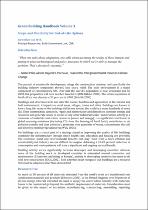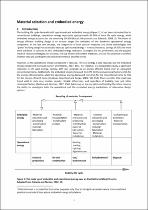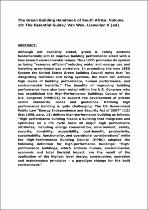JavaScript is disabled for your browser. Some features of this site may not work without it.
- ResearchSpace
- →
- Research Publications/Outputs
- →
- Book Chapters
- →
- View Item
| dc.contributor.author |
Van Wyk, Llewellyn V

|
|
| dc.date.accessioned | 2011-03-16T07:23:13Z | |
| dc.date.available | 2011-03-16T07:23:13Z | |
| dc.date.issued | 2010-11 | |
| dc.identifier.citation | van Wyk, L. 2010. Green building handbook volume 3: Scope and flexibility for end-of-life options. Alive2Green, November 2010 | en_US |
| dc.identifier.isbn | 9780620452103 | |
| dc.identifier.uri | http://hdl.handle.net/10204/4903 | |
| dc.description | Copyright: 2010 Alive2green | en_US |
| dc.description.abstract | The pursuit of sustainable development brings the construction industry, and specifically the building industry component thereof, into sharp relief. The built environment is a major component of contemporary life. Over half the world’s population is now urbanised and by 2050 that proportion will have reached two- thirds. Buildings and structures form and alter the nature, function and appearance of the natural and built environment: it impacts on rural areas, villages, towns and cities. Buildings are known to have a long life: many of the buildings still in use around the world are many hundreds of years old. Their construction, operation, repair and maintenance and demolition consume energy and resources and generate waste in excess of any other industrial sector. Construction activity is a consumer of materials and scarce resources (water and energy), is a significant contributor to global warming emissions (including CO2 from the burning of fossil fuels), contributes to air pollution (smoke and dust pollution), generates vast quantities of waste, contaminates the soil, and destroys existing vegetation. | en_US |
| dc.language.iso | en | en_US |
| dc.publisher | Alive2green Publishers | en_US |
| dc.relation.ispartofseries | Workflow request;5838 | |
| dc.subject | Buildings | en_US |
| dc.subject | Construction | en_US |
| dc.subject | South Africa | en_US |
| dc.subject | Built environment | en_US |
| dc.subject | Building industry | en_US |
| dc.subject | Infrastructure | en_US |
| dc.subject | Building technology | en_US |
| dc.subject | Green building handbook | en_US |
| dc.title | Green building handbook volume 3: Scope and flexibility for end-of-life options | en_US |
| dc.type | Book Chapter | en_US |
| dc.identifier.apacitation | Van Wyk, L. V. (2010). Green building handbook volume 3: Scope and flexibility for end-Of-Life options., <i>Workflow request;5838</i> Alive2green Publishers. http://hdl.handle.net/10204/4903 | en_ZA |
| dc.identifier.chicagocitation | Van Wyk, Llewellyn V. "Green building handbook volume 3: Scope and flexibility for end-of-life options" In <i>WORKFLOW REQUEST;5838</i>, n.p.: Alive2green Publishers. 2010. http://hdl.handle.net/10204/4903. | en_ZA |
| dc.identifier.vancouvercitation | Van Wyk LV. Green building handbook volume 3: Scope and flexibility for end-of-life options.. Workflow request;5838. [place unknown]: Alive2green Publishers; 2010. [cited yyyy month dd]. http://hdl.handle.net/10204/4903. | en_ZA |
| dc.identifier.ris | TY - Book Chapter AU - Van Wyk, Llewellyn V AB - The pursuit of sustainable development brings the construction industry, and specifically the building industry component thereof, into sharp relief. The built environment is a major component of contemporary life. Over half the world’s population is now urbanised and by 2050 that proportion will have reached two- thirds. Buildings and structures form and alter the nature, function and appearance of the natural and built environment: it impacts on rural areas, villages, towns and cities. Buildings are known to have a long life: many of the buildings still in use around the world are many hundreds of years old. Their construction, operation, repair and maintenance and demolition consume energy and resources and generate waste in excess of any other industrial sector. Construction activity is a consumer of materials and scarce resources (water and energy), is a significant contributor to global warming emissions (including CO2 from the burning of fossil fuels), contributes to air pollution (smoke and dust pollution), generates vast quantities of waste, contaminates the soil, and destroys existing vegetation. DA - 2010-11 DB - ResearchSpace DP - CSIR KW - Buildings KW - Construction KW - South Africa KW - Built environment KW - Building industry KW - Infrastructure KW - Building technology KW - Green building handbook LK - https://researchspace.csir.co.za PY - 2010 SM - 9780620452103 T1 - Green building handbook volume 3: Scope and flexibility for end-of-life options TI - Green building handbook volume 3: Scope and flexibility for end-of-life options UR - http://hdl.handle.net/10204/4903 ER - | en_ZA |









